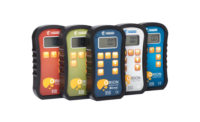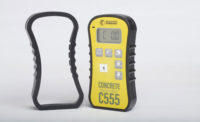New Wagner Meters Table Helps with Moisture Measurement

The Calcium Chloride test, even when performed correctly, only measures moisture vapor emissions from the top of the slab. All graphics courtesy of Wagner Meters.







No doubt about it: there are times when your project’s timeline requires you to look ahead and estimate how things are going to turn out even before the workflow puzzle is fully in place. For example, you may need to estimate what the relative humidity (RH) reading in your concrete slab will be at service conditions—even though you are not currently at those conditions.
To help you to estimate that RH reading—and to do so quickly and easily—Wagner Meters has partnered with CTLGroup, a wholly owned subsidiary of the Portland Cement Association, to release a scientifically validated, laboratory-tested estimation tool: the Service Temperature Adjustment Table, which can be accessed at www.wagnermeters.com/rhtemp/.
If you know the current, non-service conditions of your concrete slab, you can use this table to predict your at-service-conditions reading. All you have to do is use your current temperature and RH measurements to look up the estimated service conditions RH in the table.
Understanding Flooring Systems and Moisture
The moisture in concrete slabs is “chemically active” water, which interacts with the various components of flooring and adhesive systems in different ways. That’s right: flooring and adhesive systems. In other words, when looking at residential, commercial and industrial concrete flooring projects, it’s good to remember these are in fact complicated systems, which can include everything from subgrade soil, capillary breaks and vapor retarders, to patching compounds, primers and adhesives. Furthermore, all of these components respond to moisture in different ways.
And the stakes are high. Moisture-related problems can lead to costly delays, callbacks, flooring system failure and even lawsuits. So it really is necessary to utilize a system that accurately gauges a slab’s moisture dynamics to ensure successful project outcomes.
Work done by laboratories worldwide has shown that taking RH measurements at 40% of the depth of a concrete slab is far and away the best means not only to “measure the slab’s RH,” but to know what the slab’s moisture profile will look like once a finished flooring product is in place. This is because properly conducted RH testing gives a picture of what is happening within the slab itself and not only at the surface.
The calcium chloride (CaCl) testing approach essentially measures what is happening only at the surface of a concrete slab. Thus, you can conduct the CaCl test in accordance with the ASTM F1869 Standard and get an acceptable reading—but still run into flooring problems down the road. This is because the test does not actually give a proper reading of what is going on within the slab and how the slab is going to look moisture-wise once it has equilibrated. So, over time, problems emerge. (A similar problem can occur when utilizing handheld meters as the sole way to test for moisture issues.)
However, with RH testing conducted in accordance with the ASTM F2170 Standard, you get a clear picture not just of what is going on within the slab at the time of testing, but also of what the slab’s moisture condition will be once the finished flooring product is in place. In other words, you are effectively seeing what the flooring product itself will “see.”
Using the Table
The Service Temperature Adjustment Table is quick and easy to use. You simply take your current, non-service-conditions readings, find them in the table, and then use the information there to estimate what your RH readings will be at service conditions.
And having an estimation of RH at service conditions allows you to make important business decisions. For example, maybe you and a GC are discussing a project’s next steps, but the slab is not yet at service conditions. Now you can use the Service Temperature Adjustment Table as a solid basis for communicating and ensuring that things stay on track as efficiently as possible.
The ASTM F2170 Standard mandates that you measure RH at service conditions, and you will accordingly need to take your readings at those conditions. In the meantime, though, you have an effective, scientifically sound estimating tool that allows you to make decisions confidently.
So, if the table shows an estimate that falls within the manufacturer’s standards for your finished flooring product, you can reasonably move forward anticipating no problems in the actual testing. But if the estimate indicates a likely need for mitigation of some kind, you are now in possession of that information days or even weeks before you have your at-service-conditions RH readings in hand. This can accelerate your workflow considerably.
With RH measurement, you take official recordable readings at service conditions only after 72 hours. But a recent study has found that the readings you get at 24 hours are essentially identical to the ones you will see at 72 hours, thereby giving you another 48 hours of lead time in terms of confidently estimating whether your flooring project is going to proceed smoothly or not.
In other words, with the new Service Temperature Adjustment Table from Wagner Meters and CTLGroup, it’s possible to utilize the power of scientifically validated estimating tools every step of the way as you conduct RH testing. You can try it at www.wagnermeters.com/rhtemp.
Looking for a reprint of this article?
From high-res PDFs to custom plaques, order your copy today!












